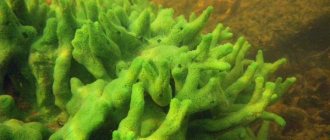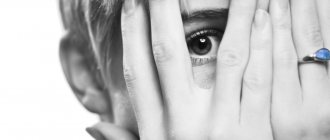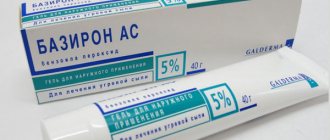Composition and release form
Oflomelid is a complex non-hormonal drug for the treatment of skin lesions. The combination of an antimicrobial component, a tissue repair agent and a local anesthetic made it possible to obtain a good, effective and relatively inexpensive drug.
Let's take a closer look at the composition of Oflomelid:
Ofloxacin is a broad-spectrum antibiotic from the fluoroquinol group, which has a powerful bactericidal effect.
Methyluracil - accelerates the penetration of medicinal substances into the epidermis, due to softening of the skin, and has a pronounced healing effect.
Lidocaine is a local anesthetic that perfectly helps relieve pain at the site of ointment application. Also, the presence of this component allows you to relieve itching and discomfort from insect bites.
The ointment has a homogeneous structure with a light consistency and light color. As a rule, this product is available in 40 gram tubes. It is necessary to store Oflomelid at room temperature - according to the manufacturer's advice, from 15 to 25 ° C. It is not advisable to store the ointment in the refrigerator or near heating devices, because If proper storage conditions are not observed, the ointment will deteriorate and lose its effectiveness.
Already from the first application to the skin, areas of inflammation decrease in size, and purulent discharge also decreases.
Oflomelide®
Oflomelid® is a combined drug that has antimicrobial, anti-inflammatory, local anesthetic, and regenerating effects. The active ingredients are ofloxacin, methyluracil and lidocaine.
Ofloxacin is a broad-spectrum antimicrobial agent from the group of fluoroquinolones. It has a bactericidal effect due to the blockade of DNA gyrase in bacterial cells. DNA gyrase is essential for bacterial DNA replication, transcription, repair, and recombination. Its inhibition leads to unwinding and destabilization of bacterial DNA and, as a result, to the death of the microbial cell.
Microorganisms highly sensitive to ofloxacin (MIC
≤
0.5 mg/l):
- gram-positive aerobes
— Staphylococcus aureus methi-S (methicillin-sensitive strains), Staphylococcus coagulase negative (coagulase-negative staphylococci: Staphylococcus epidermidis, Staphylococcus saprophyticus, Staphylococcus haemolyticus, Staphylococcus hominis, etc.);
- gram-negative aerobes -
Aeromonas hydrophila, Bordetella spp., Brucella spp., Campylobacter jejuni, Citrobacter spp. (including Citrobacter freundii), Enterobacter spp. (including Enterobacter cloacae, Enterobacter aerogenes, Escherichia coli, Haemophilus ducreyi, Haemophilus influenzae, Haemophilus parainfluenzae, Klebsiella spp. (including Klebsiella pneumonia), Moraxella (Brahamella) catarrhalis, Morganella morganii, Neisseria gonorrhoeae, Neisseria meningitides, Plesiomonas spp, Proteus spp. (Proteus mirabilis, Proteus vulgaris (indole + and indole -)), Providencia spp., Salmonella spp., Serratia (including Serratia marcescens), Shigella spp. (including Shigella sonnei), Vibrio spp. (including Vibrio cholerae, Vibrio parahaemolyticus) , Yersinia spp. (including Yersinia enterocolitica);
- anaerobes
— Clostridium perfringens, Helicobacter pylori, Propionibacterium acnes;
- other
— Chlamydia trachomatis, Legionella spp., Mycoplasma spp. (including Mycoplasma hominis).
Microorganisms moderately sensitive to ofloxacin:
Acinetobacter spp. (including Acinetobacter calcoaceticus), Bacteroides fragilis, Bacteroides urealyticus, Chlamydia psittaci, Gardnerella vaginalis, Enterococcus faecalis, Mycobacterium tuberculosis, Mycobacterium leprae, anaerobic gram-positive cocci (Peptococcus spp., Peptostreptococcus spp., Pseudomonas spp. (including P seudomonas aeruginosa), Streptococcus spp (including Streptococcus pyogenes, Streptococcus pneumoniae, Streptococcus viridians) - only penicillin-sensitive strains, Ureaplasma urealyticum.
Microorganisms resistant to ofloxacin (MIC > 1 mg/l):
Acinetobacter baumannii, most strains of Enterococcus spp., Listeria monocytogenes, Nocardia spp, (including Nocardia asteroids), methicillin-resistant strains of Staphylococcus aureus and Staphylococcus spp. (Staphylococci methi-R), Treponema pallidum.
Methyluracil is a tissue repair stimulator. Has anabolic activity. Accelerates the processes of cellular regeneration in wounds, accelerating the growth and granulation maturation of tissue and epithelization.
Lidocaine has a local anesthetic effect due to the blockade of Na+ channels, which prevents the generation of impulses in the endings of sensory neurons and the conduction of impulses along nerve fibers. When used externally, it dilates blood vessels and does not have a local irritating effect. The water-soluble (hydrophilic) and hyperosmolar base of the ointment is a mixture of polyethylene oxides (polyethylene glycols) with a molecular weight of 400 and 1500 (PEO-400 and PEO-1500 or PEG-400 and PEG-1500), providing a dehydrating (moisture-absorbing) and osmotic effect on tissues, which 20 times stronger than a 10% sodium chloride solution and lasts up to 18-20 hours.
How Oflomelid works
The drug accelerates the healing process and restoration of skin damage (subcutaneous inflammation, purulent wounds, skin damage, etc.). It has an antimicrobial effect against various pathogenic microorganisms (staphylococci and streptococci), has an anesthetic effect and accelerates cell regeneration processes.
Ofloxacin has a selective effect without disturbing the structure of the body's cells, easily penetrates deep into tissues and accelerates the process of cleansing tissues from pathogenic microbes.
The antimicrobial effect persists even in the presence of pus and necrotic masses. However, it is worth noting that if their number is large, then it is necessary to first remove pus and dead tissue mechanically with a sterile instrument, resorting to the help of medical personnel to treat the wound. And only after treating the wound, apply a breathable gauze bandage with Oflomelid to the affected area.
This product copes well with purulent rashes. It is also suitable for those who want to get rid of subcutaneous acne on the face and body. Oflomelid ointment is often used for acne on the back, applying for several hours on clean skin. Penetrating into the deep layers of the epidermis, the product helps the body cope with the pathogenic microflora that is located at the source of inflammation.
Oflomelid 30g ointment
Clinical and pharmacological group
Antibacterial agents
Description
Ointment for external use
Pharmacotherapeutic group
Antimicrobial combination agent
Tradename
Oflomelid®
International nonproprietary name
ofloxacin 1% + methyluracil 4% + lidocaine 3%
Dosage form
ointment for external use.
Compound
per 100 g: active ingredients: ofloxacin - 1 g, dioxomethyltetrahydropyrimidine (methyluracil) -4 g, lidocaine hydrochloride monohydrate (in terms of lidocaine hydrochloride) - 3 g; excipients: methyl parahydroxybenzoate (nipagin or methylparaben), propyl parahydroxybenzoate (nipazoly or propylparaben), propylene glycol, macrogol-1500 (low molecular weight polyethylene glycol-1500, polyethylene oxide-1500), macrogol-400 (low molecular weight polyethylene glycol-400, polyethylene oxide-400).
CodeATX
[D06BX]
Pharmacological properties
Oflomelid® is a combination drug that has antimicrobial, anti-inflammatory, local anesthetic, and regenerating effects. The active ingredients are ofloxacin, methyluracil and lidocaine. Ofloxacin is a broad-spectrum antimicrobial agent from the group of fluoroquinolones. It has a bactericidal effect due to the blockade of DNA gyrase in bacterial cells. DNA gyrase is necessary for replication, transcription, repair and recombination of bacterial DNA. Its inhibition leads to unwinding and destabilization of bacterial DNA and, as a result, to the death of the microbial cell. Microorganisms highly sensitive to ofloxacin (MIC ≤ 0.5 mg/l): gram-positive aerobes – Staphylococcus aureus methi-S (methicillin-sensitive strains), Staphylococcus coagulase negative (coagulase-negative staphylococci: Staphylococcus epidermidis, Staphylococcus saprophyticus, Staphylococcus haemoly ticus, Staphylococcus hominis and etc.); gram-negative aerobes - Aeromonas hydrophila, Bordetella spp., Brucella spp., Campylobacterjejuni, Citrobacter spp. (including Citrobacter freundii), Enterobacter spp. (including Enterobacter cloacae, Enterobacteraerogenes, Escherichia coli, Haemophilus ducreyi, Haemophilus influenzae, Haemophilus parainfluenzae, Klebsiella spp. (including Klebsiella pneumonia), Moraxella (Brahamella) catarrhalis, Morganellamorganii, Neisseria gonorrhoeae, Neisseria meningitides, Plesiomonasspp, Proteus spp. ( Proteus mirabilis, Proteus vulgaris (indole + and indole -)), Providencia spp., Salmonella spp., Serratia (including Serratia marcescens), Shigella spp. (including Shigella sonnei), Vibrio spp. (including Vibrio cholerae, Vibrioparahaemolyticus), Yersinia spp. (including Yersinia enterocolitica) ; anaerobes - Clostridium perfringens, Helicobacter pylori, Propionibacterium acnes; others - Chlamydia trachomatis, Legionella spp., Mycoplasma spp. (including Mycoplasma hominis). Microorganisms moderately sensitive to ofloxacin: Acinetobacter spp. (including Acinetobacter calcoaceticus), Bacteroides fragilis, Bacteroides urealyticus, Chlamydia psittaci, Gardnerella vaginalis, Enterococcus faecalis, Mycobacterium tuberculosis, Mycobacterium leprae, anaerobic gram-positive cocci (Peptococcus spp., Peptostreptococcus spp., Pseudomonas spp. (including Pseudomonasaeruginosa), Streptococcus spp. (including Streptococcus pyogenes, Streptococcus pneumoniae, Streptococcus viridians) - only penicillin-sensitive strains, Ureaplasma urealyticum. Microorganisms resistant to ofloxacin (MIC > 1 mg/l): Acinetobacter baumannii, most strains of Enterococcus spp., Listeria monocytogenes, Nocardia spp, (including Nocardia asteroids), methicillin-resistant strains of Staphylococcus aureus and Staphylococcus spp. (Staphylococci methi-R) , Treponema pallidum. Methyluracil is a tissue repair stimulator. Has anabolic activity. Accelerates the processes of cellular regeneration in wounds, accelerating the growth and granulation maturation of tissue and epithelialization. Lidocaine has a local anesthetic effect due to the blockade of Na+ channels, which prevents the generation of impulses at the endings of sensory neurons and the conduction of impulses along nerve fibers. When applied externally, it dilates blood vessels and does not have a locally irritating effect. The water-soluble (hydrophilic) and hyperosmolar base of the ointment is a mixture of polyethylene oxides (polyethylene glycols) with a molecular weight of 400 and 1500 (PEO-400 and PEO-1500 or PEG-400 and PEG-1500), providing a dehydrating (moisture-absorbing) and osmotic effect on tissues, which 20 times stronger than 10% sodium chloride solution and lasts up to 18-20 hours.
Indications for use
Infected wounds of various localization and etiology in the first (purulent-necrotic) phaser wound process, incl. accompanied by severe pain syndrome (infected burns of the II-IV degree, bedsores, trophic ulcers, postoperative and post-traumatic wounds and fistulas, wounds after opening abscesses, phlegmons, post-surgical treatment of abscessed boils, carbuncles, hidradenitis, suppurating atheromas, lipomas, etc.).
Contraindications
Individual hypersensitivity to the components of the drug, pregnancy, lactation, children under 18 years of age.
Use during pregnancy
Contraindicated.
Method of administration and dose
Externally, 1 time per day for 1-2 weeks. After standard treatment of wounds and burns, the ointment is applied directly to the wound surface in a thin layer (after which a sterile gauze bandage is applied) or on a gauze bandage followed by application to the lesion. Tampons soaked in ointment are loosely filled into the cavities of purulent wounds after their surgical treatment, and gauze turundas with ointment are inserted into the fistula tracts. When treating purulent wounds, the ointment is used once a day, when treating burns - daily or 2-3 times a week, depending on the amount of purulent discharge. The maximum daily dose should not exceed 100 g. The duration of treatment depends on the dynamics of cleansing wounds from purulent exudate and the timing of relief of the inflammatory process.
Side effect
Allergic reactions.
Use with other drugs
There have been no cases of drug interactions that would lead to a decrease in the effectiveness and safety of the drugs used.
Release form
Ointments, creams, gels
Release form
Ointment for external use. 30 g, 50 g or 100 g in aluminum tubes. 30 g, 50 g or 100 g in orange glass jars, sealed with plastic lids. 200 g, 400 g in polymer jars with first opening control for the hospital with 5 instructions for use attached. 1000 g in polymer jars with a screw cap for the hospital with 5 instructions for use. 1000 g, 2000 g in orange glass jars, sealed with plastic lids, for hospital use with 5 instructions for use. Each tube or jar of 30 g, 50 g, 100 g with instructions for use in a cardboard pack.
Storage conditions
In a place protected from light at a temperature of 15 to 25 ° C. Keep out of the reach of children.
Best before date
Tubes:4 years. Banks: 4 years. After opening the jar, use within 3 months. Do not use after the expiration date.
Terms of release from pharmacies
on prescription
Indications for use
Oflomelid has a complex antimicrobial and antibacterial effect, it is used to treat:
- Acne;
- Acne;
- Acne;
- Inflammatory processes on the skin;
- Closed comedones;
- Skin diseases (except for fungal infections);
- Infected wounds (including mixed microflora);
- Damage to the skin of the face;
- Burns;
- Difficult to heal ulcers.
Side effects
If the drug is used incorrectly, the risk of an allergic reaction sharply increases.
The reasons for which are most often:
- High skin sensitivity to active substances;
- Applying the drug in a thick layer;
- Presence of contraindications for use.
Immediate reactions may be accompanied by:
- Skin rashes;
- Burning;
- Itching;
- Local swelling;
- Redness;
- Urticaria;
- Dermatitis.
Since the composition contains an antibiotic, it is not recommended to use Oflomelid on an ongoing basis, but it is also necessary that the duration of the course of treatment be sufficient so that the bacteria do not have time to develop resistance. As a rule, at least 5 days per affected area.
Do not use simultaneously with sulfonamide drugs, pyrazolone derivatives, or cytostatics. If the patient has been taking antibiotics from the fluoroquinol group, for example Levofloxacin, for a year, then the effectiveness of Oflomelid will be weaker, and the likelihood of developing side effects will also increase.
Martana
Dosage form
| Oflomelid® | Ointment for external use reg. No.: LSR-007163/09 from 06/26/13 - Indefinitely |
Release form, packaging and composition of Oflomelid®
Ointment for external use is white or almost white.
| 1 g | |
| ofloxacin | 10 mg |
| dioxomethyltetrahydropyrimidine (methyluracil) | 40 mg |
| lidocaine hydrochloride (monohydrate form) | 30 mg |
Excipients: macrogol 1500 (polyethylene oxide 1500, low molecular weight polyethylene glycol 1500), macrogol 400 (polyethylene oxide 400, low molecular weight polyethylene glycol 400), propylene glycol, methyl parahydroxybenzoate (nipagin or methylparaben), propyl parahydroxybenzoate (nipazole or propylparaben).
30 g - aluminum tubes (1) - cardboard packs. 200 g - polymer jars. 400 g - polymer jars. 1000 g - polymer jars. 1000 g - dark glass jars. 2000 g - dark glass jars.
Clinical and pharmacological group: A drug with antibacterial, local anesthetic and tissue regeneration improving effects for external use
Pharmacotherapeutic group: Antimicrobial combined agent
pharmachologic effect
The combined drug has antimicrobial, anti-inflammatory, local anesthetic, regenerating effects.
Ofloxacin is a broad-spectrum antimicrobial agent from the group of fluoroquinolones. It has a bactericidal effect by blocking DNA gyrase in bacterial cells. Highly active against gram-positive microorganisms: Staphylococcus spp. (including Staphylococcus aureus, Staphylococcus epidermidis), Streptococcus spp.; gram-negative microorganisms: Pseudomonas aeruginosa, Acinetobacter spp., Escherichia coli, Klebsiella spp., Proteus spp., Enterobacter spp., Citrobacter spp.; anaerobes: Propionibacterium acnes; intracellular microorganisms: Chlamydia spp. (including Chlamydia trachomatis), Legionella spp., Mycoplasma spp.
Methyluracil is a tissue repair stimulator. Has anabolic activity. Accelerates the processes of cellular regeneration in wounds, accelerating the growth and granulation maturation of tissue and epithelization.
Lidocaine has a local anesthetic effect due to the blockade of sodium channels, which prevents the generation of impulses in the endings of sensory neurons and the conduction of impulses along nerve fibers. When used externally, it dilates blood vessels and does not have a local irritating effect.
The water-soluble hydrophilic (hyperosmolar) base of the ointment is a mixture of polyethylene oxides (polyethylene glycols) with a molecular weight of 400 and 1500, providing a dehydrating (moisture-absorbing) effect on tissue that is 20 times stronger than the hyperosmotic effect of a 10% sodium chloride solution.
Pharmacokinetics
Data on the pharmacokinetics of Oflomelid® are not provided.
Indications for Oflomelid®
Infected purulent wounds of various localization and etiology in the first (purulent-necrotic) phase of the wound process, incl. accompanied by severe pain:
- infected burns of II-IV degree;
- bedsores;
- trophic ulcers;
- postoperative and post-traumatic wounds and fistulas;
- wounds after opening abscesses, phlegmons, after surgical treatment of abscessed boils, carbuncles, hidradenitis, festering atheromas, lipomas.
Open list of ICD-10 codes
Dosage regimen
The drug is used externally, 1 time/day for 1-2 weeks. The maximum daily dose should not exceed 100 g of ointment. The duration of treatment depends on the dynamics of cleansing wounds from purulent exudate and the timing of relief of the inflammatory process.
After standard treatment of wounds and burns, the ointment is applied directly to the wound surface in a thin layer (after which a sterile gauze bandage is applied) or on a gauze bandage, followed by application to the lesion.
Tampons soaked in ointment are loosely filled into the cavities of purulent wounds after surgical treatment, and gauze turundas with ointment are inserted into the fistula tracts.
When treating infected burns, the drug is used daily or 2-3 times a week, depending on the amount of purulent discharge.
Side effect
Possible: allergic reactions.
Contraindications for use
- pregnancy;
- lactation period;
- children and adolescents up to 18 years of age;
- hypersensitivity to the components of the drug.
Use during pregnancy and breastfeeding
The drug is contraindicated during pregnancy and lactation (breastfeeding).
Use in children
Contraindication: children and adolescents under 18 years of age.
Overdose
Data on overdose of Oflomelid® are not provided.
Drug interactions
There were no cases of interaction with drugs that would lead to a decrease in the effectiveness and safety of the drugs used.
Storage conditions for the drug Oflomelid®
The drug should be stored out of the reach of children, protected from light at a temperature of 15°C to 25°C.
Shelf life of Oflomelid®
Shelf life: 2 years.
Terms of sale
The drug is available with a prescription.
Information taken from the website: https://www.vidal.ru/drugs/oflomelid__21700
Methods of using Oflomelid
The choice of method of application is based on the number of rashes and their severity. For a full effect on the skin, it is necessary to use the drug correctly.
Before use, be sure to remove all makeup and wash with a good cleanser (it is recommended to wash the affected areas with boric, sulfur or tar soap), then pat your face with a paper towel to remove all remaining moisture.
For acne
You should lubricate pimples with Oflomelid very carefully, without putting pressure on them. When applying, avoid contact with healthy skin to avoid drying or irritation. This advice will be especially relevant for those with dry, sensitive and thin skin.
For 10 days, apply the ointment to problem areas twice daily in a thin layer. It is allowed to repeat the course no earlier than 1 month (otherwise the skin becomes dehydrated and dry).
After the drug is applied, it is necessary to leave it for fifteen to twenty minutes so that the active substance penetrates the epidermis. Then you need to apply a second layer and leave it longer, at least forty minutes, until the ointment dries completely and is absorbed.
If you are planning an event: after the required time has passed, if the remnants of the product are noticeable, they must be removed with a clean napkin or cotton wool moistened with an alcohol solution of boric acid, salicylic acid, or vodka (it is better not to remove it with calendula or propolis tincture, because .they give the skin a yellow color). You should not wet pimples with water to avoid re-inflammation. It is worth remembering that microbes multiply better in warm and moist skin, so pimples should always be dehydrated.
As a rule, rashes, if there are many of them, completely go away after one or two weeks, and sometimes even earlier. The skin becomes smooth and even, and the remaining scars and scars after a pimple breakout heal quickly. If there is a large number of inflammations on the face, then Oflomelid is applied at night and washed off in the morning. As a rule, new rashes do not appear during this treatment. Once you have conquered all the defects, you can move on to spot application of the product in places where new, sporadic acne and pimples appear.
In this photo, oflomelid was applied to a pimple in the inflammation stage and to the places where blackheads were removed
For acne
You can also apply Oflomelid to acne-affected areas of the skin in the form of an application under a breathable bandage and leave for a longer period of 5-7 hours. This provokes accelerated maturation and complete healing of acne, which will subsequently break out on its own, or they can be removed mechanically, or they will completely disappear due to the death of microorganisms, the reduction of pus in them and the functioning of the immune system.
Oflomelid 50 g ointment for external use
Release form
Ointment for external use.
Package
50 g.
pharmachologic effect
The combined drug has antimicrobial, anti-inflammatory, local anesthetic, regenerating effects.
Oflomelid has antimicrobial, anti-inflammatory, local anesthetic, and regenerating effects.
Ofloxacin is a broad-spectrum antimicrobial agent from the group of fluoroquinolones. It has a bactericidal effect by blocking DNA gyrase in bacterial cells. Highly active against gram-positive microorganisms: Staphylococcus spp. (including Staphylococcus aureus, Staphylococcus epidermidis), Streptococcus spp.; gram-negative microorganisms: Pseudomonas aeruginosa, Acinetobacter spp., Escherichia coli, Klebsiella spp., Proteus spp., Enterobacter spp., Citrobacter spp.; anaerobes: Propionibacterium acnes; intracellular microorganisms: Chlamydia spp. (including Chlamydia trachomatis), Legionella spp., Mycoplasma spp.
Methyluracil is a tissue repair stimulator. Has anabolic activity. Accelerates the processes of cellular regeneration in wounds, accelerating the growth and granulation maturation of tissue and epithelization.
Lidocaine has a local anesthetic effect due to the blockade of sodium channels, which prevents the generation of impulses in the endings of sensory neurons and the conduction of impulses along nerve fibers. When used externally, it dilates blood vessels and does not have a local irritating effect.
The water-soluble hydrophilic (hyperosmolar) base of the ointment is a mixture of polyethylene oxides (polyethylene glycols) with a molecular weight of 400 and 1500, providing a dehydrating (moisture-absorbing) effect on tissue that is 20 times stronger than the hyperosmotic effect of a 10% sodium chloride solution.
Indications
— Infected purulent wounds of various localization and etiology in the first (purulent-necrotic) phase of the wound process, incl. accompanied by severe pain:
— infected burns of II-IV degree;
- bedsores;
- trophic ulcers;
— postoperative and post-traumatic wounds and fistulas;
- wounds after opening abscesses, phlegmons, after surgical treatment of abscessed boils, carbuncles, hidradenitis, suppurating atheromas, lipomas.
Contraindications
- pregnancy;
- lactation period;
- children and adolescents up to 18 years of age;
- hypersensitivity to the components of Oflomelid.
Compound
Active ingredients: ofloxacin 10 mg; dioxomethyltetrahydropyrimidine (methyluracil) 40 mg; lidocaine hydrochloride (in the form of monohydrate) 30 mg;
Excipients: macrogol 1500 (polyethylene oxide 1500, low molecular weight polyethylene glycol 1500), macrogol 400 (polyethylene oxide 400, low molecular weight polyethylene glycol 400), propylene glycol, methyl parahydroxybenzoate (nipagin or methylparaben), propyl parahydroxybenzoate (nipazole or propylparaben)
Directions for use and doses
Oflomelid is used externally, 1 time per day for 1-2 weeks. The maximum daily dose should not exceed 100 g of ointment. The duration of treatment depends on the dynamics of cleansing wounds from purulent exudate and the timing of relief of the inflammatory process.
After standard treatment of wounds and burns, the ointment is applied directly to the wound surface in a thin layer (after which a sterile gauze bandage is applied) or on a gauze bandage, followed by application to the lesion.
Tampons soaked in ointment are loosely filled into the cavities of purulent wounds after surgical treatment, and gauze turundas with ointment are inserted into the fistula tracts.
When treating infected burns, the drug is used daily or 2-3 times a week, depending on the amount of purulent discharge.
Side effects
Possible: allergic reactions.
Storage conditions
In a place protected from light, at a temperature of 15–25 °C.
Best before date
2 years.
Analogs
If you want something inexpensive, but very effective, then we recommend turning your attention to the following drugs. Oflomelid has the following analogues, which are divided into several groups.
Structural
These creams contain components of similar (or the same) action (one or more), but in different dosages, these include:
| Name | Price |
| Sintomycin | ~100 rubles |
| Levosin | ~100 rubles |
| Levomethyl | ~70 rubles |
| Levomekol | ~ 150 rubles |
| Fastin 1 | ~ 1000 rubles |
| Erythromycin ointment | ~ 120 rubles |
| Tetracycline ointment | ~ 130 rubles |
| Dioxidine | ~ 450 rubles |
No antibiotic
These ointments and creams have different ingredients, dosages, indications and contraindications, but they have similar pharmaceutical effects.
Non-structural analogues include:
| Name | Price |
| Liniment Vishnevsky | ~ 80 rubles |
| Ichthyol ointment | ~ 80 rubles |
| Stellanin | ~ 420 rubles |
| Metrogyl gel (Rozamet cream) | ~ 220 rubles (~ 450 rubles) |
| Baneocin | ~ 400 rubles |
Reviews
We invite you to read reviews from ordinary people about the use of oflomelid for acne, and if you still have any questions, you can always ask them to a cosmetologist or pharmacist on our cosmetic forum.
“I tried for a long time to get rid of acne on my face, but not a single product really helped me and even caused various irritations. One day, a dermatologist advised me to try Oflomelid, as well as a pharmacy mash with erythromycin. Looking at the low price, I finally decided to try it. The effect exceeded all my expectations. After the course of treatment, my face became much clearer and there was less inflammation. Of course, the rashes have not completely gone away, but such extensive acne rashes as there were before no longer occur; single pimples, when treated with Oflomelid and mash, quickly resolve or mature, and I can remove them mechanically.”
Ksenia, 21 years old, Moscow
“I work as a sales consultant and it’s clear that the first thing you are judged on is your appearance. Since early youth I have suffered from rashes on my face. I never treated them with anything and thought that this was the lot of girls, all these ointments and creams. But during the next exacerbation, clients came to the store, looked at me condescendingly and smiled. I didn’t understand what was going on until my friend one day said, “Yes, with these pimples, you look like a snotty boy!” At first, of course, I was offended, but later I realized that I still needed to do something about it. At the pharmacy, the pharmacist recommended Oflomelid ointment to me. I used it together with a fine facial scrub. After a few months, not a trace of pimples remained, the skin became cleaner, and there were fewer post-acne spots.”
Anton, 25 years old, Zvenigorod










